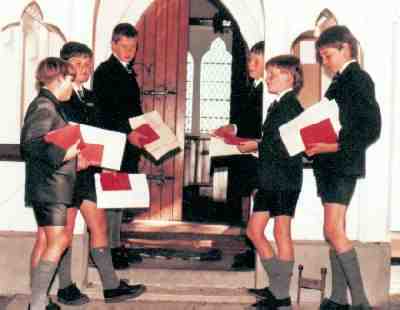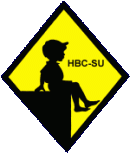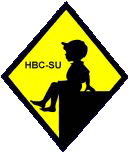 > >
Figure 1.--The elaborate school uniforms worn by boys until recent years has evolved into a simple grey suit or blazer and dress pants. The boys at this New Zealand school wear grey suits. |

|
School uniforms in America, until recently, have generally been associated with high-cost exclusive schools for the well to do. Even in England where most children wear uniforms to school, elaborate school uniforms were mostly associated with what many Brits considered to be hoity-toity elite preparatory and public (i.e. private secondary) schools for the rich. The historical origin of uniforms, however, is quite different. Uniforms were first instituted in 16th Century England at the charity schools for poor children. It was not until the 19th Century that the great English public schools began instituting uniforms and even later for them to be widely accepted at state schools--especially state elementary schools.
While the focus of HBC is on the modern era. HBC plans to also collect information on ancient civilizations. Schools in Europe or relatively modern developments as during the medevil era writing and academic education was lost except for a small number, mostly mooks. Schools were, however, common in many ancient civilizations. While some information is available on these schools, there is little to suggest that they wore destinctive uniforms. HBC has, however, only collected a limited amount of information on the topic.
The Arabs armed with Ilam burst out of the Arabian desert in the 7th century and by the 8th century had founded a powerful empire centered on Baghdad. The Arabs then spread Islam through North Africa and into Spain. Centers of leaning called "medersas" or Islamic schools were established throughout the Arab world. They were inspired by the schools established in Baghdad. The first medersas were founded by the Marinid sultans, during the 14th century.
After the fall of Rome, formal schooling in the West disappeared. The rare vestages of school were the song schools of the cathedrals and monestaries. The boys chosen at first were taught to prepare them for holy orders. We have only limited information about the clothing for these early choristers. Formaly schooling in Europe outside of church schools were rare in Europe until about the 10th century. Thenumber of children attending schools was very limited for several more centuries. There were similarities in the development of schools throught Europe, but the pattern varied significantly in many areas. We have little information at this time about clothing at these early schools. There does appear to have been some uniformity in the clothing worn by the choristers in the early song schools. This appears to have been less common in the secullar schols which slowly developed during the secomd millenium.
We have very limited information on schoolwear in Europe during the early modern era. One fascinating view is Jan Steen's Dutch depiction of "The Village School" painted about 1665. We have few indications that uniforms were commonly worn. One of the few exceptions thatvw have noted are English charity schools. School uniforms in England wer for many years associated with children from ealthy families attending exclusive private schools. In fact it was the children attnding charity schools that first ore uniforms, in part to set them apart and to clothe them as cheaply as possible. These historic costumes are still worn by boys at some of Englan's famed hospital schools. We are not fimilar to similar developments on the Cintinent, but our informaion is still very limited.
Many believe that school uniforms are a superficial aspect of a school. Superficial or not, school uniform is part of the history of British education. The reason that Britain's great public schools began instituting uniforms was much the same reason that educators in America's dreadfull urban schools have begun to require uniforms. The English public school in the 18th and early 19th century had become anarchic, dangerous places in which boys from aristocrats and wealthy families as they wished and played voluntary games in whatever worn and battered gear was to hand. Interestingly many of our most popular modern sports (rugby, soccer, football, cricket, and baseball) originated in the informal, off rough and caotic play of English school boys. Conditions were so bad that many parents refused to send their boys and instead had them educated at home until they were ready for university. The uniformity in clothing was one of the measures designed to replace caos with disciplined order. Along with compulsory games, stricter supervision of the pupils' lives and morals, and a broadening of the classical curriculum, school uniform was an essential characteristic of the reformed public schools that emerged by the late 19th Century as some of the most effective and prestgious schools in Europe.
|
Once the idea of school uniforms took hold, it was seized upon by the British as obsession. The many new public schools founded in Victorian England to meet the needs of administrators for an expanding empire followed the example of the established public schools. The new preparatory schools founded to prepare younger boys to enter the public schools also adopted uniforms. The new uniforms were a visible symbol as a way of establishing their social status. No where else in Europe or in America did distinctive uniforms for school boys become such a uniformily accepted principle. The British school uniform followed empire as new public schools were founded in the colonies which adopted the styles set by the established schools--no matter how unsuitable to tropical climates.
More than is generally recognized today, children from affluent families in the 18th, 19th, and even early 20th Centuries were likely to have very extensive wardrobes. A school boy even in the late 18th Century could own a dozen shirts, almost as many cravats, half a dozen waist coats and tightly fitted breeches, hats, gloves, stockings, hankerchiefs, and heeled shoes. Their wardrobes became much more complicated in the 19th Century, especially as sports became more organized and specialized sport equipment became required. When girls started going to boarding schools in the 19th Century, their wardrobes were even more elaborate. A typical girl in a boarding school might own a dozen dresses of varying styles and formality for differt occasions, a decorative quilted petticoat, a fancy hat, a hooped petticoat, decorative pinafores, a cloak, a corset, heeled shoes, stockings, gloves, and hankerchiefs.
|
The English state schools followed the lead of the prestigous public schools also began requiring uniforms. The initial public schools to require uniforms were boarding
schools, but many private and state day schools also began requiring uniforms. The Education Act of 1870 finally commited Britain to financing a modern school system for every child. Efore the passage of the Act influential groups in Britain had opposed educating the poor. The number of state schools rpidly increased. Almost all of the new state grammar schools (academically selective schools) aping the standards of the public schools, decided on distinguish their boys from the pupils at the less academically oriented elementary and secondary modern schools. Even today, comprehensive (non-selective secondary school) schools that wish to be associated with the grammar school tradition adopt blazers in the school colors. It is ironic that originating as a badge of poverty, school uniforms came to repreent high social status.
It was within the public schools that uniform destinctions were most significant. Small destinctions in the uniform were used to delineate status within the school itself. In a peculiarly English
fashion, uniform defined the hierarchy and reminded the new boy of the deference he owed to the prefect and the 'blood'. As late as the 1950s, unwritten rules about dress: how many buttons done up on the blazer, what angle to wear the straw hat, and many other small details were still used to mark the ladder of rank and privilege.
The social revolution of the 1960s ended much of the English obsession with school uniforms. There had been schoolboy rebellions against uniform in the past. World War II had ended some of the more expensive or ludicrous uniform items, but it was the widespread youth revolt of the late-1960s that had the greatest impact. In most schools, uniform remained, though modified in the direction of informality. Most of the sillier hierarchical touches disappeared. A few public schools abolished uniform altogether. Most later regretted it. Noteably, the two most distinctive uniforms (Eton and Christ's Hospital) were largely unchanged. One observer suggests that perhaps they were so eccentric it was difficult to know what on earth to change to.
|
School uniforms hve been much less common in Europe than Britain. We do note a variety of images from European counties (France, Germany, Russia, and others) suggesting that school uniform were worn in the 19th century. We have, however, very little information on these uniforms and how widely they were worn. Many were based on military styles. In the 20th century, smovks were commonly worn in several countries (Belgium, France, Italy, and Spain).
Several countries have been influencd by European, primarily English, school uniforms. Many former English colonies adopted Engkish school uniforms. This was the case in Australia, New Zealand, and South africa, but not Canada. I'm not sure why Canada ws an exception, perhaps because of the American influence. British school uniforms had someinfluence on American private schools and as some elementry schools began adopting school uniforms in the 1980s, British styles were influentil, especilly for girl's uniforms. Many former Britsh colonies in Africa, the Caribbean, and Asia also adopted school uniform, although often simplified and hited to styles suitable for the tropics. Several countries in South America (Chile and Peru and to a lesser extent Ecuador). Other South American countries (Argentina, Bolivia, and Uruguay) seemed more influenced by Italy and Spain as smocks were adopted. Many Middle Eastern countries also adopted smocks for schoool children. The Prussians appeared to have had an impact on school uniforms in Japan.
Totalitarian societies have taken different approaches to school uniforms. The German NAZIs never had a school uniform. Italy's Fascist commonly had children wear smocks. The Soviet Communists adopted school uniforms from an early phase of the Revolution. The Soviets encouraged East European Communist countries to adopt school uniforms. Most did. Here the East Germans was an exception. Our information on Eastern European Communist school uniforms, however, is very limited at this time. Hopefully our European readers will provide us some information on trends in their country. School uniforms wre dropped as Russia emerged from Communism, primarily because students refused to wear them. We have less information about developments in Eastern Europe after the fall of the former satellite Communist governments.
School uniform remains an issue between pupils and school authorities. It would be odd indeed if this were not the case. But it is wrong to imagine that the adolescent rebel really wants uniform to be abolished or that abolition would put a stop to the arguments. Most Amereican schools have dress codes. Often parents and students participate in setting the code. But that is not to say there are fewer disagreements over clothes at American schools than at British schools. In fact, far from reducing disputes about what could or could not be worn, the dress code was open to more conflicting interpretations than the uniform regulations had ever been. Enforcing a uniform is a relatively simple matter compared to the constant small issues arrisng from a never ending decisions that have to be made on the never ending appearance of new clothing styles and looks.
Related Blazer Pages in the Boys' Historical Web Site
[Main school uniform blazer page]
[Main blazer page]
[Australian blazers]
[English blazers]
[New Zealand blazers]
[Scottish blazers]
Navigate the Relate Boys Historical Clothing Uniform Garment Pages
[Main garment page]
[Blazers]
[Bookbag]
[Caps]
[Coats]
[Hose]
[Kilts]
[Pants]
[Shirts]
[Shoes]
[Smocks
[Suits]
[Seaters]
[Ties]
Navigate the Boys' Historical Clothing School Uniform Country Pages
[Return to the Main School Uniform Page]
[Return to the Main National School Uniform Page]
[Australia]
[England]
[France]
[Germany]
[Ireland]
[Italy]
[Japan]
[New Zealand]
[Poland]
[Singapore]
[Scotland]
[Singapore]
[United States]
Navigate the HBC School Pages
[Activities]
[Chronology]
[Clothing styles]
[Countries]
[Debate]
[Economics]
[Garment]
[Gender]
[Hair]
[History]
[Home trends]
[Literary characters]
[School types]
[Significance]
[Transport and travel
[Uniform regulations]
[Year level]
[Other topics]
[Images]
[Links]
[Registration]
[Tools]
[Return to the Historic Boys' School Home]
